Shrubs
Showing 1–16 of 35 results
-
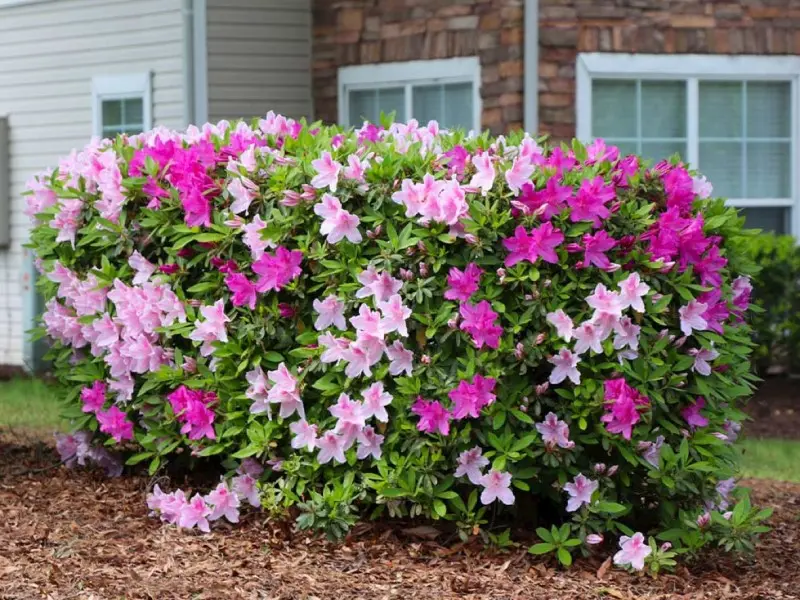
Azalea
$0.00Add to LawnPartial sunFull shade4'-8'Not deer resistantAzalea (Rhododendron spp.) is a popular flowering shrub known for its stunning, trumpet-shaped blooms and lush foliage. Belonging to the Rhododendron genus, Azaleas bring vibrant color to landscapes in early spring, with some varieties blooming again in summer and fall. Available in a variety of colors including shades of pink, red, purple, white, and orange, Azaleas create a striking visual impact in gardens and are a favorite for foundation plantings, borders, and woodland gardens. Azaleas range in size from compact, low-growing varieties (around 2-3 feet) to larger shrubs reaching up to 6-10 feet, depending on the species and cultivar. These shrubs thrive in partial shade to filtered sun, especially in hot climates, and prefer well-draining, acidic soil rich in organic matter. They are generally hardy in USDA zones 6-9, though some cold-tolerant varieties can grow in zone 5. Azaleas are relatively low-maintenance but benefit from occasional pruning after their main bloom cycle to maintain shape and encourage denser growth. Regular watering is essential, especially during dry spells, as Azaleas have shallow roots that can dry out quickly. Mulching around the base helps retain soil moisture and maintain an acidic pH. With their vibrant flowers, glossy green foliage, and adaptability, Azaleas are ideal for adding a splash of color and elegance to shaded gardens, foundation plantings, and naturalized areas. Their versatility and beauty make them a timeless choice for landscapes ranging from traditional to informal. -
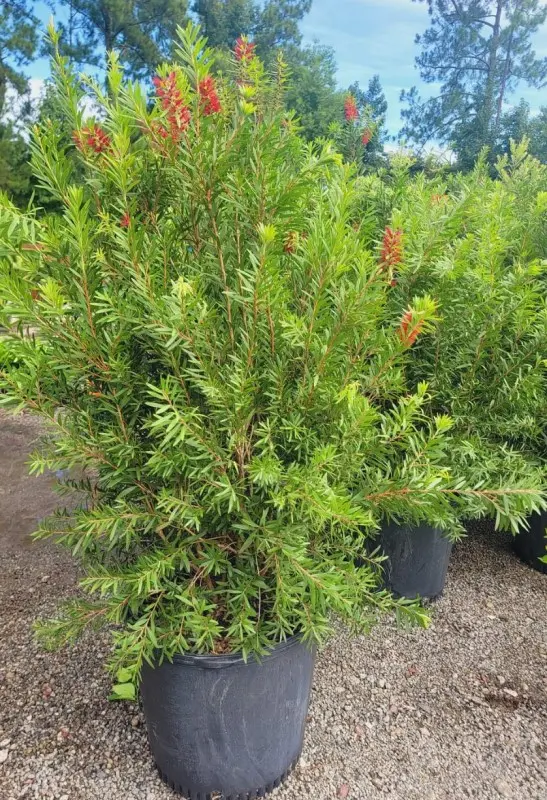
Bottle Brush
$0.00Add to LawnFull sun-5'-10'Not deer resistantBottle Brush (Callistemon spp.), commonly known as Red Bottlebrush or simply Bottlebrush, is a distinctive evergreen shrub or small tree admired for its vibrant, bottlebrush-shaped flowers in shades of bright red, pink, or sometimes yellow. Native to Australia, this plant produces dense, cylindrical flower spikes that resemble a bottle brush, giving it its common name. These striking blooms typically appear from spring through summer and attract pollinators like hummingbirds, bees, and butterflies, adding lively color and activity to gardens. Bottle Brush grows to about 5 to 15 feet tall, though some varieties can reach up to 20 feet or more, depending on the species and growing conditions. This plant thrives in full sun and is hardy in USDA zones 8-11. It adapts well to a range of soil types, including sandy and loamy soils, as long as they are well-draining, and is drought-tolerant once established. Bottle Brush also tolerates coastal conditions, making it an ideal choice for coastal or Mediterranean-style landscapes. Generally low-maintenance, Bottle Brush benefits from occasional pruning after its blooming season to maintain shape and encourage bushier growth. It’s also resistant to pests and diseases, making it a resilient option for various climates. Used as a focal point, hedge, or accent shrub, Bottle Brush brings a unique, exotic look to landscapes with its unusual flower form and vivid colors, adding year-round interest to both formal and naturalized garden designs. -
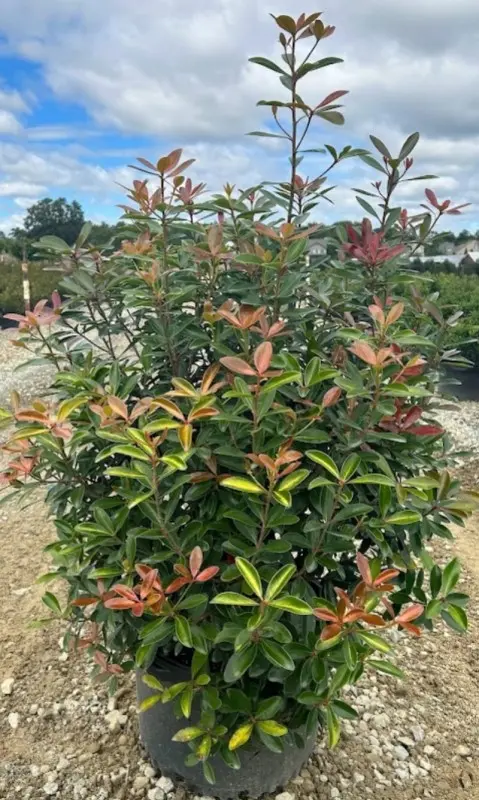
Cleyera
$0.00Add to LawnFull sunPartial sun5'-10'Not deer resistantCleyera (Ternstroemia gymnanthera), also known as Japanese Cleyera, is an elegant evergreen shrub prized for its glossy foliage and year-round appeal. Native to Japan, Korea, and China, Cleyera showcases leaves that emerge as bronze or red, maturing to a deep, lustrous green with a subtle red tint on the undersides. In spring or early summer, small, fragrant, cream-colored flowers bloom, followed by small, dark red berries in fall, providing seasonal interest and attracting birds. Cleyera typically grows to about 8 to 10 feet in height, with a spread of 5 to 6 feet, making it ideal for hedges, privacy screens, or foundation plantings. This shrub thrives in partial to full shade but can also tolerate full sun in cooler climates. It performs best in USDA zones 7-10, preferring well-draining, acidic soil. Cleyera is relatively drought-tolerant once established and can handle high humidity, making it well-suited to southern landscapes. Low-maintenance and versatile, Cleyera requires minimal pruning to maintain its shape, usually done in early spring. With its rich foliage, subtle blooms, and adaptability, Cleyera adds structure and beauty to both formal and informal garden designs. Whether used as a hedge, accent shrub, or in mixed borders, Cleyera provides year-round greenery and a refined touch to shaded or partially shaded landscapes. -
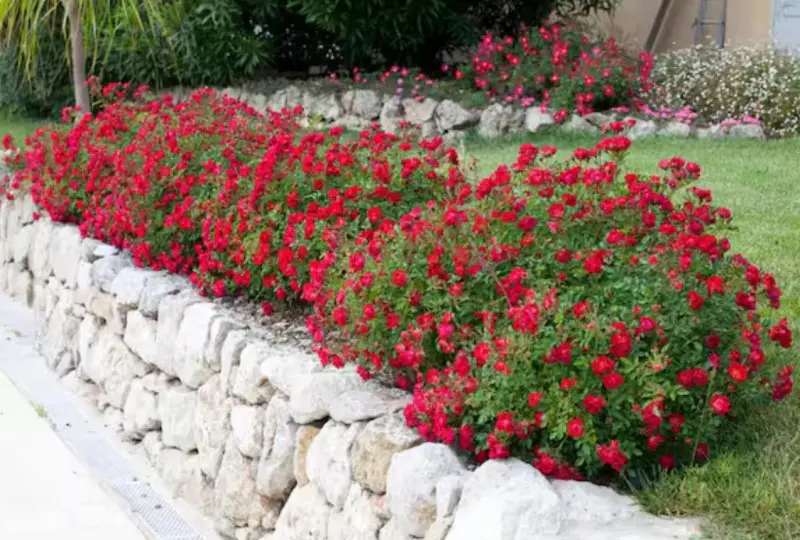
Drift Rose
$0.00Add to LawnFull sun-2'-4'Not deer resistantDrift Rose (Rosa spp.), a hybrid rose variety, is celebrated for its compact, ground-covering growth and continuous blooming. A cross between traditional groundcover roses and miniature roses, Drift Roses were developed to combine hardiness and disease resistance with a low-growing, spreading form. Blooming in shades of pink, coral, red, white, apricot, and peach, they offer a prolific display of small, clustered flowers from spring through fall, providing season-long color with minimal maintenance. Drift Roses typically grow 1 to 2 feet tall and can spread 3 to 4 feet wide, making them perfect for borders, rock gardens, container plantings, and ground cover. They thrive in full sun and are hardy in USDA zones 4-11. Like other roses, Drift Roses prefer well-draining soil rich in organic matter and benefit from consistent watering, though they are somewhat drought-tolerant once established. Low-maintenance by design, Drift Roses require only a light pruning in early spring to encourage fresh growth and maintain their compact shape. They are self-cleaning, so spent blooms drop naturally, making deadheading unnecessary. Resistant to common rose diseases, Drift Roses offer beautiful blooms, resilience, and ease of care, making them an ideal choice for gardeners who want a hardy, colorful rose without the fuss. Their spreading habit and rich color palette make Drift Roses a stunning addition to both formal and informal garden designs. -
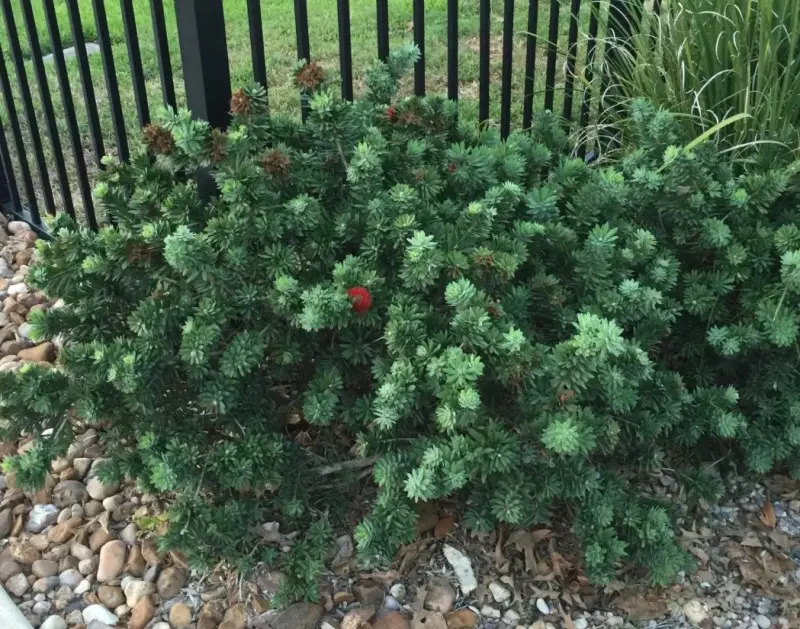
Dwarf Bottle Brush
$0.00Add to LawnFull sun-2'-4'Not deer resistantDwarf Bottle Brush (Callistemon viminalis ‘Little John’), also known as Little John Bottlebrush, is a compact, evergreen shrub cherished for its bright red, bottlebrush-shaped flowers and dense, bushy growth. This smaller variety of the traditional Bottle Brush grows to about 3 to 5 feet tall and wide, making it ideal for smaller spaces, borders, and containers. The vibrant, cylindrical blooms appear from spring through fall, attracting hummingbirds, bees, and butterflies with their nectar-rich flowers. Dwarf Bottle Brush thrives in full sun and is hardy in USDA zones 8-11. It prefers well-draining soil and is drought-tolerant once established, making it suitable for xeriscaping or low-water gardens. This shrub also tolerates a range of soil types, including sandy and loamy soils, and is relatively salt-tolerant, making it a good choice for coastal landscapes. Low-maintenance by nature, Dwarf Bottle Brush requires minimal pruning to maintain its shape, although light trimming after blooming can encourage denser growth. Resistant to pests and diseases, this plant is a resilient addition to any garden. With its rich red blooms, compact form, and ease of care, Dwarf Bottle Brush adds bold color and texture to landscapes, fitting beautifully in both formal and naturalized garden settings. -
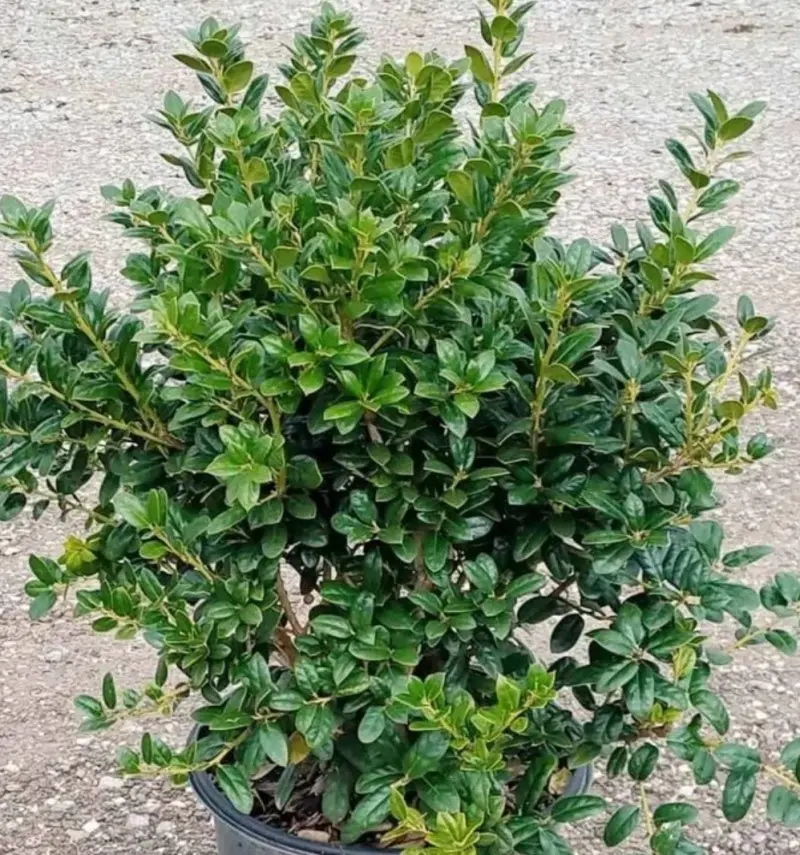
Dwarf Burford Holly
$0.00Add to LawnFull sunPartial sun3'-8'Not deer resistantDwarf Burford Holly (Ilex cornuta ‘Burfordii Nana’) is a compact, evergreen shrub known for its dense, dark green foliage, attractive red berries, and low-maintenance needs. A smaller version of the traditional Burford Holly, this dwarf variety is ideal for small spaces, foundation plantings, and low hedges. It produces glossy, oval-shaped leaves with a single spine at the tip, and in fall, female plants develop clusters of bright red berries that persist through winter, adding seasonal interest and providing food for birds. Dwarf Burford Holly typically grows to about 3 to 5 feet in height and width, forming a rounded, bushy shape. Hardy in USDA zones 7-9, it thrives in full sun to partial shade and prefers well-draining soil, though it is adaptable to a range of soil types. This shrub is relatively drought-tolerant once established and is also resistant to heat, humidity, and urban pollution, making it a durable choice for various landscape settings. Low-maintenance and slow-growing, Dwarf Burford Holly requires minimal pruning to maintain its shape and can be lightly trimmed after the berries appear if desired. Its resilience to pests and diseases, along with its compact size and attractive foliage, makes it an excellent choice for low hedges, borders, or as an accent plant. With its year-round greenery and seasonal berry display, Dwarf Burford Holly brings structure, color, and wildlife-friendly appeal to landscapes with minimal effort. -
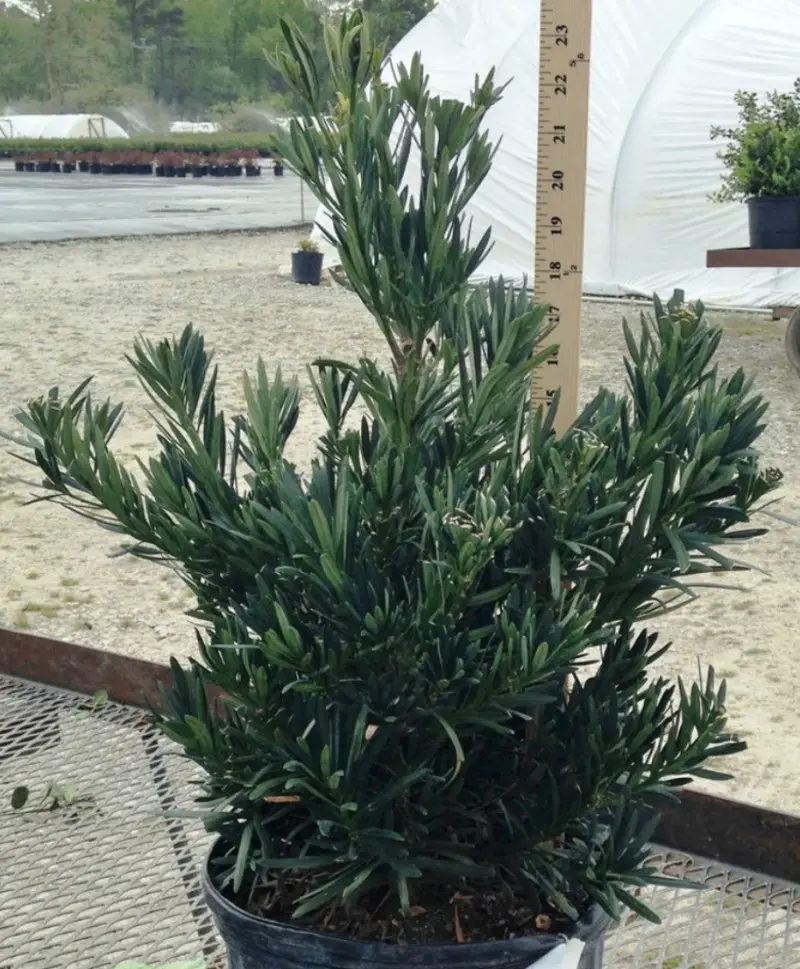
Dwarf Japanese Yew
$0.00Add to LawnFull sunPartial sun3'-5'Deer resistantDwarf Japanese Yew (Taxus cuspidata ‘Nana’) is a compact, evergreen shrub known for its finely textured, needle-like foliage and neat, mounding growth habit. Native to Japan, this variety of Japanese Yew offers dense, dark green foliage that retains its color year-round, providing reliable structure and greenery to garden beds, borders, and foundation plantings. With its slow-growing and compact nature, Dwarf Japanese Yew is ideal for small spaces or as an accent in larger landscapes. Typically reaching a height and spread of 3 to 4 feet, Dwarf Japanese Yew has a naturally rounded form that requires minimal pruning to maintain. It thrives in partial to full shade but can also handle full sun in cooler climates. This shrub is hardy in USDA zones 4-7 and prefers well-draining soil. Although Dwarf Japanese Yew is moderately drought-tolerant once established, it benefits from occasional watering during extended dry periods. Known for its resilience, this yew variety is resistant to deer and most pests, making it a low-maintenance choice for gardens. Dwarf Japanese Yew’s dense foliage makes it well-suited for low hedges, foundation plantings, or as a background shrub in mixed borders. Its elegant, evergreen presence and adaptability allow it to add year-round color and texture to formal and informal garden designs alike. -
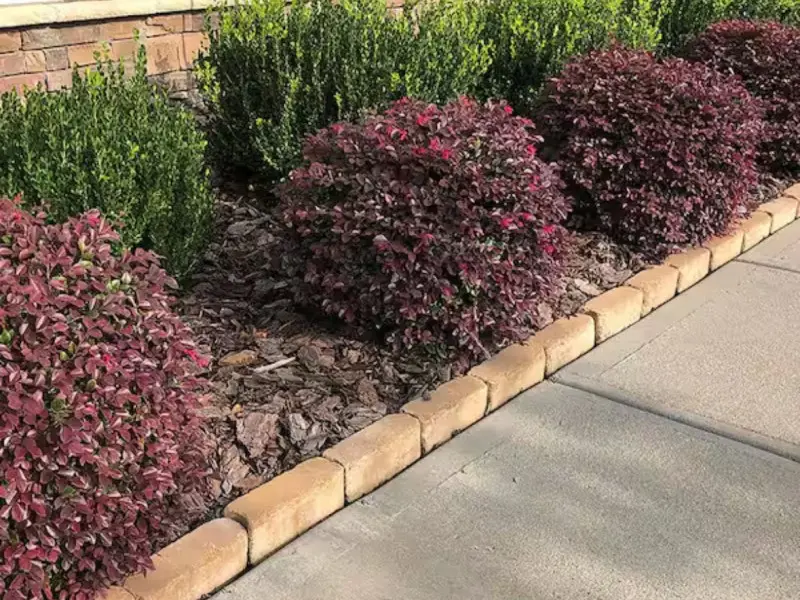
Dwarf Loropetalum
$0.00Add to LawnFull sunPartial sun1'-3'Not deer resistantDwarf Loropetalum (Loropetalum chinense var. rubrum) is a compact, evergreen shrub known for its striking, deep purple foliage and vibrant, fringe-like flowers that bloom in shades of pink or fuchsia. Originating from Asia, Dwarf Loropetalum offers a unique color contrast in the garden, with leaves that retain their purple hue year-round and bright clusters of spider-like blooms in spring and sporadically throughout the year. Typically growing to about 2 to 3 feet in height and width, Dwarf Loropetalum is ideal for small spaces, borders, foundation plantings, or containers. It thrives in USDA zones 7-10 and performs best in full sun to partial shade, with full sun promoting the richest foliage color. This shrub prefers well-draining, slightly acidic soil and is moderately drought-tolerant once established, although it benefits from regular watering in dry conditions. Low-maintenance by nature, Dwarf Loropetalum requires minimal pruning to maintain its rounded form, though light trimming after blooming can encourage bushier growth and additional blooms. Resistant to pests and diseases, it is a popular choice for adding year-round color and texture to landscapes. With its vibrant foliage, compact size, and eye-catching flowers, Dwarf Loropetalum brings a bold, contemporary touch to both traditional and modern garden designs. -
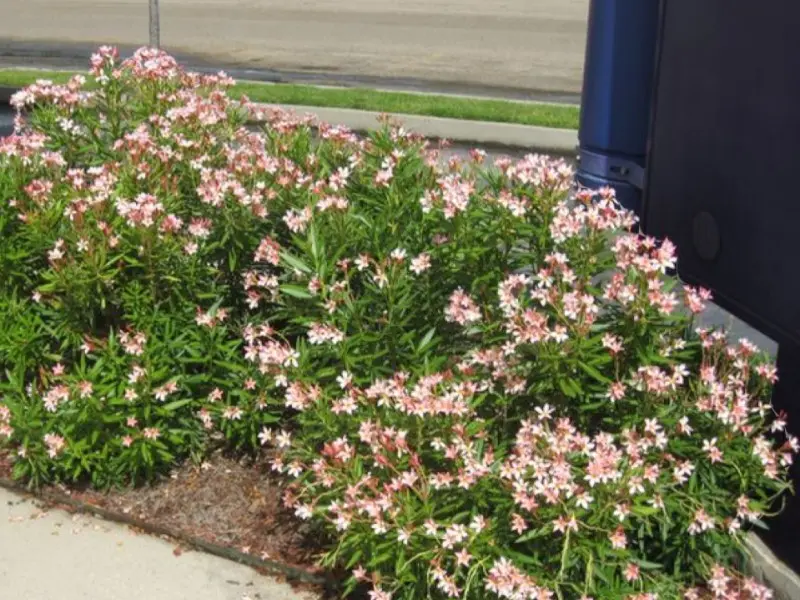
Dwarf Oleander
$0.00Add to LawnFull sun-3'-5'Deer resistantDwarf Oleander (Nerium oleander), is a compact, evergreen shrub cherished for its vibrant, colorful blooms and resilient nature. This smaller variety of the traditional oleander reaches about 3 to 6 feet in height and width, making it ideal for smaller landscapes, borders, or container plantings. Dwarf Oleander produces abundant, showy flowers in shades of pink, red, or white from late spring through fall, adding long-lasting color to gardens and attracting pollinators like butterflies. Thriving in full sun, Dwarf Oleander is hardy in USDA zones 8-11 and is well-suited to warm climates, including coastal areas due to its salt tolerance. It prefers well-draining soil and is highly drought-tolerant once established, making it an excellent choice for low-water or xeriscape gardens. Additionally, Dwarf Oleander is heat-tolerant and can withstand a variety of soil conditions, further enhancing its versatility. Low-maintenance and pest-resistant, Dwarf Oleander requires minimal care beyond occasional pruning to maintain its shape and encourage more blooms. However, it’s essential to handle this plant with care, as all parts of the oleander are toxic if ingested. Despite this, its hardiness, compact form, and continuous blooms make Dwarf Oleander a popular choice for adding lush color and structure to warm-climate gardens. -
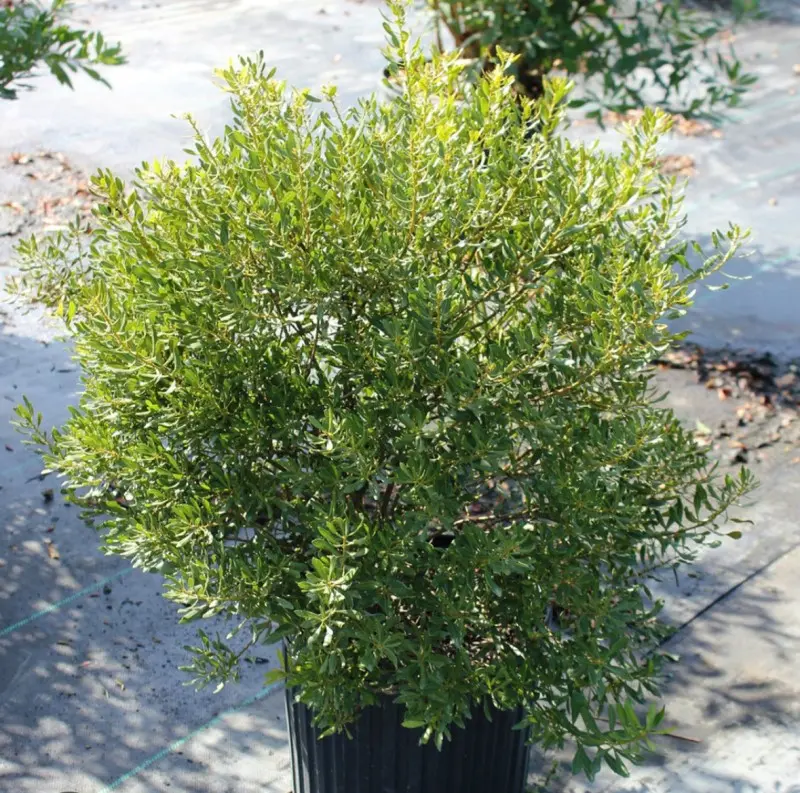
Dwarf Wax Myrtle
$0.00Add to LawnFull sunPartial sun3'-5'Not deer resistantDwarf Wax Myrtle (Myrica cerifera ‘Nana’), also known as Southern Wax Myrtle or Dwarf Southern Bayberry, is a compact, evergreen shrub prized for its aromatic foliage and adaptability. This dwarf variety of the traditional Wax Myrtle has narrow, dark green leaves that emit a pleasant fragrance when crushed. Native to the southeastern United States, Dwarf Wax Myrtle is an excellent choice for low hedges, foundation plantings, or as a ground cover in naturalized or coastal landscapes. Typically growing to about 2 to 3 feet in height and spread, Dwarf Wax Myrtle has a dense, rounded form that requires minimal pruning to maintain. Hardy in USDA zones 7-10, this shrub thrives in full sun to partial shade and is highly tolerant of poor, sandy, or acidic soils. It is also highly drought-tolerant once established, as well as resistant to salt, making it ideal for coastal gardens and xeriscape landscapes. Low-maintenance and pest-resistant, Dwarf Wax Myrtle adds structure and greenery with minimal care. Its root system helps control erosion, making it useful for slopes or banks, and its aromatic foliage naturally deters deer. With its compact size, resilience, and pleasant fragrance, Dwarf Wax Myrtle is a versatile and practical choice for gardeners looking to add year-round greenery to sunny or partially shaded areas in the landscape. -
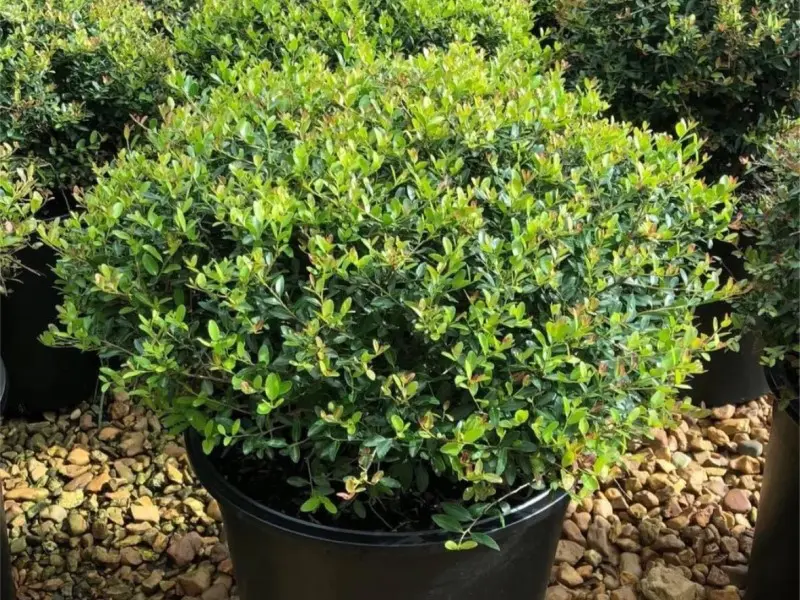
Dwarf Yaupon Holly
$0.00Add to LawnFull sunPartial sun2'-4'Deer resistantDwarf Yaupon Holly (Ilex vomitoria 'Nana'), also known as Dwarf Yaupon, is a hardy, compact evergreen shrub valued for its dense, rounded form and low-maintenance nature. Native to the southeastern United States, this cultivar of the traditional Yaupon Holly features small, oval, glossy green leaves that retain their color year-round, creating a tidy, refined look in the landscape. Dwarf Yaupon Holly is dioecious, meaning separate male and female plants are needed for berry production; female plants produce small red berries in winter, which add seasonal interest and attract birds. Typically growing to about 2 to 4 feet tall and wide, Dwarf Yaupon Holly is ideal for borders, foundation plantings, low hedges, and formal garden designs. It thrives in full sun to partial shade and is hardy in USDA zones 7-10. Adaptable to various soil types, including clay and sandy soils, Dwarf Yaupon Holly tolerates drought, salt, and urban conditions, making it versatile for challenging environments. Low-maintenance and slow-growing, this holly requires minimal pruning to maintain its shape and can be lightly trimmed in late winter or early spring if desired. Resistant to pests and diseases, Dwarf Yaupon Holly is a popular choice for gardeners seeking a durable, evergreen shrub that provides year-round structure and visual appeal with minimal effort. Its compact size and adaptability make it a practical, beautiful addition to both traditional and modern landscapes. -
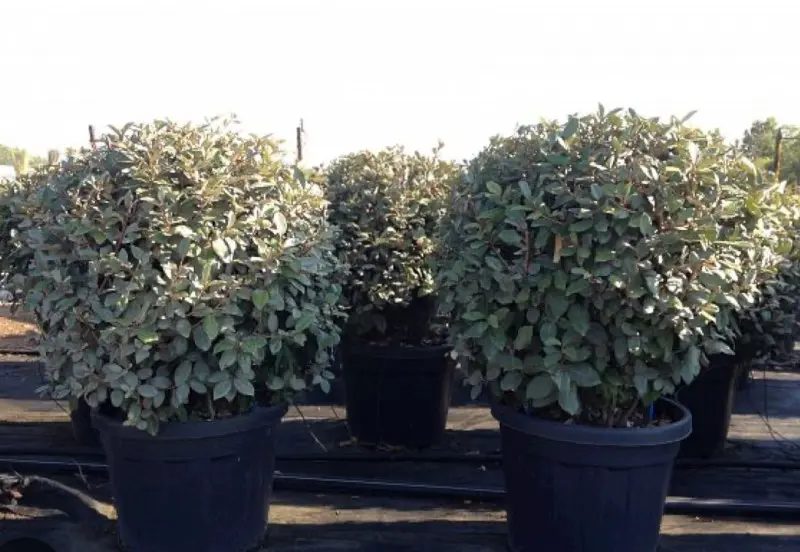
Elaeagnus
$0.00Add to LawnFull sunPartial sun5'-10'Deer resistantElaeagnus (Elaeagnus spp.), also known as Silverberry or Autumn Olive, is a hardy, evergreen or semi-evergreen shrub prized for its silvery-green foliage, fragrant flowers, and adaptability. Native to Asia and parts of Europe, Elaeagnus is known for its dense, fast-growing habit, which makes it an excellent choice for privacy screens, hedges, or windbreaks. In late fall, it produces small, tubular, fragrant flowers that are creamy white or silver and attract pollinators. These are followed by small, red or silver edible berries that ripen in late winter or spring, providing food for wildlife. Elaeagnus can grow to heights of 10 to 15 feet and a similar spread, though it can be pruned to maintain a smaller size. Thriving in USDA zones 6-10, this shrub is extremely adaptable, tolerating a variety of soil types, from sandy to clay soils, as long as they are well-draining. Elaeagnus is also highly drought-tolerant and can handle salt spray, making it suitable for coastal or xeriscape gardens. Its resilient nature allows it to thrive in both full sun and partial shade. With minimal maintenance needs, Elaeagnus benefits from occasional pruning to maintain shape and remove any leggy growth. It is generally resistant to pests and diseases, further adding to its appeal as a low-maintenance shrub. With its fast growth, dense foliage, and seasonal interest, Elaeagnus is ideal for gardeners seeking a tough, attractive shrub that provides both privacy and a touch of elegance to the landscape year-round. -
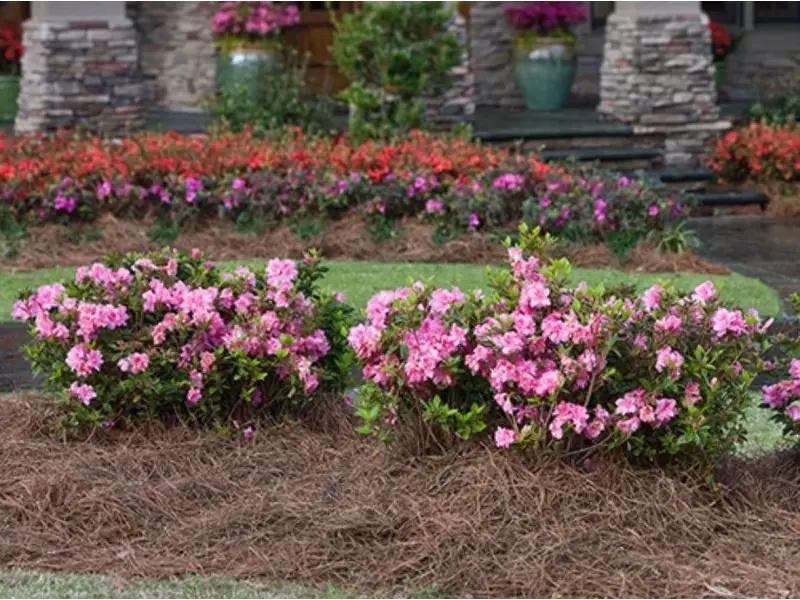
Encore ( Dwarf ) Azalea
$0.00Add to LawnPartial sunFull shade2'-5'Not deer resistantEncore Dwarf Azalea (Rhododendron spp.) is a compact, evergreen azalea known for its vibrant, repeat blooming cycle and manageable size, making it perfect for smaller gardens or container plantings. Developed as part of the Encore Azalea series, these dwarf varieties are prized for their extended blooming period, producing multiple flushes of flowers from spring through fall. Available in an array of colors, including shades of pink, red, purple, and white, Encore Dwarf Azaleas add lively color to landscapes for much of the growing season. Dwarf Encore Azaleas typically grow to about 2 to 3 feet in height and width, forming a tidy, rounded shape ideal for borders, foundation plantings, or mixed garden beds. These azaleas thrive in USDA zones 6-9, preferring partial sun to filtered shade, although they can handle more sun than traditional azaleas, which promotes more prolific blooming. They prefer well-draining, acidic soil that is rich in organic matter and require regular watering, particularly during dry spells. Low-maintenance and relatively pest-resistant, Encore Dwarf Azaleas benefit from light pruning immediately after their spring bloom to encourage a fuller shape and more blooms in subsequent cycles. With their evergreen foliage, compact form, and repeat-blooming capability, Encore Dwarf Azaleas are an excellent choice for adding continuous color, structure, and low-maintenance beauty to both traditional and modern garden designs. -
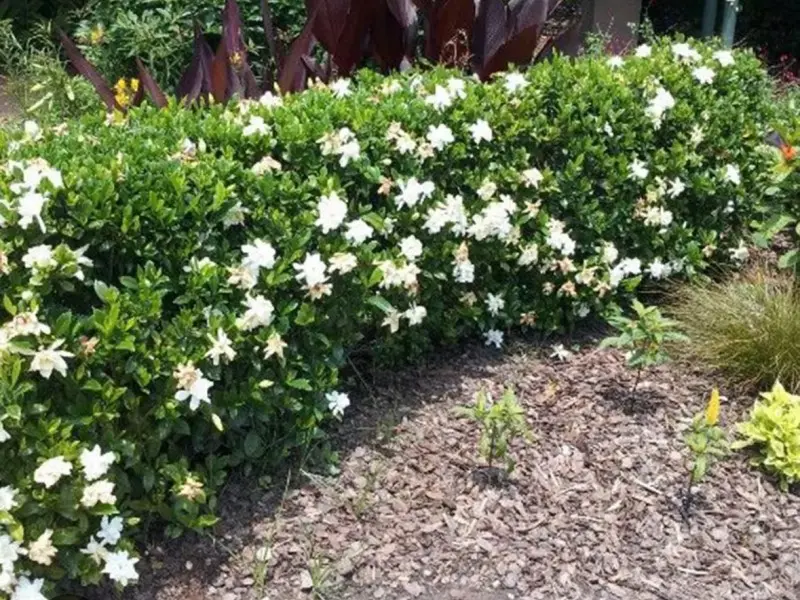
Gardenia
$0.00Add to LawnFull sunPartial sun3'-8'Not deer resistantGardenia (Gardenia jasminoides), also known as Cape Jasmine, is an evergreen shrub cherished for its exquisite, creamy white blooms and intoxicating fragrance. Native to Asia, Gardenia is popular for its large, waxy flowers that bloom from late spring through summer, filling gardens with a rich, sweet scent. The flowers stand out beautifully against the plant’s dark green, glossy leaves, creating a classic and elegant appearance. Gardenia typically grows 3 to 8 feet tall and wide, though dwarf varieties are available for smaller spaces and container plantings. This plant thrives in partial shade to full sun, preferring morning sun with afternoon shade in hotter climates. It is hardy in USDA zones 8-11, though it can be grown in cooler zones as a container plant that is brought indoors for winter. Gardenias require well-draining, acidic soil rich in organic matter and benefit from regular watering, as they are not drought-tolerant. To maintain its shape and encourage blooming, Gardenia may need light pruning after its flowering period. It can be sensitive to pests like aphids and spider mites, as well as soil pH, which should be kept slightly acidic to prevent yellowing leaves. Despite these care requirements, Gardenia’s stunning flowers, delightful fragrance, and glossy foliage make it a prized choice for hedges, borders, and accent plantings. Ideal for gardens with a touch of formality or as standalone statement plants, Gardenias bring timeless beauty and aromatic charm to any landscape. -

Indian Hawthorn
$0.00Add to LawnFull sunPartial sun3'-5'Not deer resistantIndian Hawthorn (Rhaphiolepis indica) is a compact, evergreen shrub cherished for its rounded form, glossy, dark green leaves, and showy clusters of fragrant, star-shaped flowers that bloom in shades of pink or white. Native to southern China and other parts of Asia, this shrub has become popular in gardens for its low-maintenance nature and its consistent, year-round appeal. In spring, Indian Hawthorn produces dense clusters of blooms that attract pollinators like bees and butterflies, and as the season progresses, the flowers give way to small, blue-black berries that birds enjoy. Indian Hawthorn typically grows to a manageable size of 3 to 6 feet in height and width, making it ideal for small hedges, foundation plantings, and container gardening. It thrives in full sun to partial shade and is hardy in USDA zones 7-10. This shrub prefers well-draining soil and has good tolerance to drought, salt, and urban pollution, making it versatile for various landscape settings, including coastal areas. Requiring little care, Indian Hawthorn benefits from occasional pruning to shape or control size, usually done after its blooming period to preserve flower buds for the next season. Its resistance to pests and diseases, combined with its ornamental beauty, makes Indian Hawthorn a favorite for low-maintenance landscapes. Perfect for borders, mixed beds, or as a standalone accent, Indian Hawthorn provides a year-round visual interest with minimal upkeep, adding color and structure to gardens with its blooms, berries, and dense foliage. -
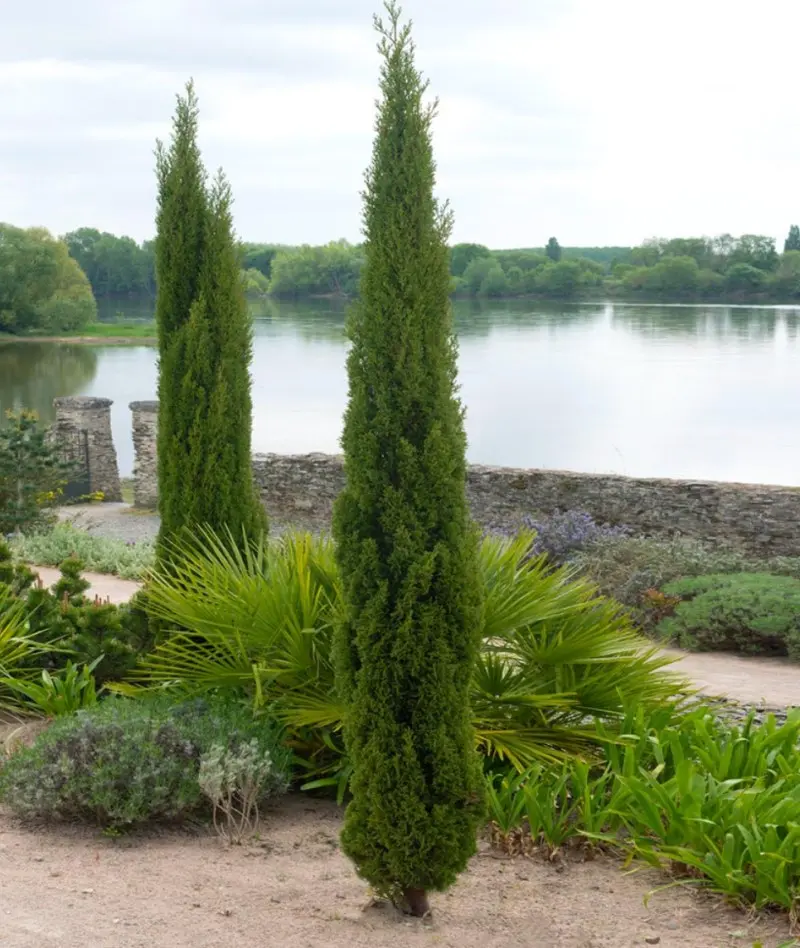
Italian Cypress
$0.00Add to LawnFull sunPartial sun50'Not deer resistantItalian Cypress (Cupressus sempervirens), also known as Mediterranean Cypress, is an iconic evergreen tree known for its slender, columnar form and stately presence. Native to southern Europe and western Asia, this tree brings a touch of elegance and Mediterranean charm to landscapes. Its dense, scale-like, dark green foliage grows tightly along tall, upright branches, giving it a pencil-thin silhouette that reaches heights of 40 to 60 feet, with a spread of only 3 to 5 feet. Italian Cypress trees are ideal for vertical accents, formal gardens, and lining driveways or pathways. Italian Cypress thrives in full sun and is hardy in USDA zones 7-11. It is adaptable to various well-draining soil types, including sandy and loamy soils, and is both drought-tolerant and low-maintenance once established. This tree is also resilient in hot, dry climates and tolerates urban pollution, making it an excellent choice for city or suburban environments. With minimal pruning required to maintain its naturally narrow shape, Italian Cypress is a low-maintenance option for gardeners who want structure and height without extensive upkeep. Occasionally, it may benefit from trimming to remove any dead or damaged branches. With its tall, elegant shape and durability, Italian Cypress is perfect for creating dramatic focal points, framing entrances, or adding a touch of classic sophistication to landscapes.

